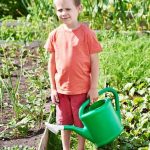Gardening herbs and vegetables offers a multitude of benefits that go beyond simply having access to fresh produce. Not only does it allow you to save money on groceries, but it also provides therapeutic benefits that can improve your mental and physical well-being. Whether you have a spacious backyard or a small balcony, nurturing your own herb and vegetable garden can be an incredibly rewarding experience.
One of the most significant advantages of gardening herbs and vegetables is the ability to enjoy freshly picked produce right from your own backyard or windowsill. The taste of homegrown herbs and vegetables simply cannot compare to store-bought alternatives. Additionally, having your own garden allows you to select varieties that are not commonly found in supermarkets, expanding your culinary options and introducing new flavors into your meals.
Beyond the satisfaction of growing your own food, gardening also has therapeutic benefits. Spending time outdoors, connecting with nature, and engaging in physical activity can reduce stress levels and promote relaxation. Whether it’s tending to plants, digging in the soil, or simply observing the growth of your garden over time, these activities can provide a sense of fulfillment and tranquility.
Moreover, gardening herbs and vegetables can lead to significant cost savings in the long run. With rising grocery prices and concerns about food security, having a sustainable source of fresh produce can help reduce expenses and reliance on external sources. By investing time and effort into growing your own herbs and vegetables, you can significantly cut down on grocery bills while ensuring the quality of what reaches your plate.
In the following sections of this article, we will delve deeper into various aspects of gardening herbs and vegetables. From selecting the perfect location for your garden to troubleshooting common problems encountered along the way, this comprehensive guide will provide you with all the information needed to embark on a successful herb and vegetable gardening journey. So let’s dig in.
Selecting the Perfect Location for Your Herb and Vegetable Garden
Choosing the right location for your herb and vegetable garden is crucial to its success. The proper spot will provide your plants with the necessary sunlight, good soil quality, and easy access to water sources. Here are some key factors to consider when selecting the perfect location for your garden:
- Sunlight exposure: Most herbs and vegetables require at least six hours of direct sunlight each day. Choose a location that receives ample sunlight, preferably in the morning or afternoon when the sun is less intense. Observe your potential garden spot throughout the day to ensure that it receives enough sunlight.
- Soil quality: The soil should be well-draining and rich in organic matter. Conduct a soil test to determine its pH level and nutrient content. You can easily purchase a home testing kit or send a sample to a local agricultural extension office for analysis. Based on the test results, you may need to amend the soil with compost, aged manure, or other organic matter to create an optimal growing environment.
- Accessibility to water sources: Make sure your chosen location is within reach of a water source, such as a hose or irrigation system. Regular watering is essential for herb and vegetable gardens, so having convenient access to water will make this task easier and more efficient.
To help you choose the perfect location for your herb and vegetable garden, here are some possible options:
- Backyard: If you have sufficient space in your backyard, it can be an ideal location for your garden. Ensure that there is enough room for your plants’ growth and that they have access to adequate sunlight.
- Balcony or patio: Don’t let limited outdoor space deter you from gardening herbs and vegetables. Many varieties can thrive in containers on balconies or patios as long as they receive enough sunlight.
- Community gardens: If you don’t have access to suitable outdoor spaces at home, consider joining a local community garden. These shared spaces provide designated plots for individuals to grow herbs and vegetables, allowing you to enjoy the benefits of gardening even without a personal garden space.
By carefully selecting the perfect location for your herb and vegetable garden, you are setting your plants up for success. Take into account sunlight exposure, soil quality, and accessibility to water sources when choosing your garden spot. Whether it’s in your backyard, on a balcony, or in a community garden plot, with the right location, you can look forward to bountiful harvests of fresh produce right at your fingertips.
Understanding the Different Types of Herbs and Vegetables to Grow
When it comes to gardening herbs and vegetables, there is a wide variety of options to choose from based on personal preferences and climate conditions. Understanding the different types of herbs and vegetables available can help gardeners make informed choices about what to grow in their own gardens.
Popular Herbs
- Basil: Basil is a versatile herb that adds a fresh, fragrant flavor to many dishes. It is easy to grow and thrives in warm temperatures with well-drained soil.
- Mint: Mint is known for its refreshing scent and taste, and it can be used in various culinary creations. It grows quickly but tends to spread, so planting it in containers or designated areas is recommended.
- Rosemary: Rosemary is an evergreen shrub that adds a savory flavor to dishes. It requires full sun and well-draining soil, making it suitable for Mediterranean climates or indoor pots.
- Thyme: Thyme is a popular herb with small leaves that pack a flavorful punch. It can be grown both as ground cover in the garden or in containers, as long as it receives plenty of sunlight.
Common Vegetables
- Tomatoes: Tomatoes are one of the most popular vegetables grown in home gardens because of their juicy sweetness and versatility. They require full sun, consistent watering, and support through trellises or cages.
- Lettuce: Lettuce is an easy-to-grow leafy green vegetable that is perfect for salads and sandwiches. It prefers cooler temperatures with partial shade and evenly moist soil.
- Bell Peppers: Bell peppers come in various colors and add crunchiness and nutrition to meals. They thrive in warm weather with at least six hours of sunlight per day.
- Zucchini: Zucchini plants produce an abundance of summer squashes that are delicious when cooked or used in baking recipes. They prefer rich soil, ample sunlight, and frequent watering.
Additionally, there are plenty of lesser-known herbs and vegetables that can be grown in home gardens. For example, cilantro, dill, and parsley are herbs with unique flavors that can elevate a range of cuisines. Swiss chard, kale, and eggplant are vegetables that offer different textures and colors to diversify any garden or meal.
Gardeners should consider the specific climate and growing conditions of their area when selecting which herbs and vegetables to grow. It is also advisable to research specific planting guides for each herb or vegetable to ensure proper care and maintenance throughout the growing season.
Preparing the Soil for Optimal Herb and Vegetable Growth
One of the most important aspects of successful herb and vegetable gardening is ensuring that your soil is properly prepared. The quality of your soil will directly affect the growth and productivity of your plants. Here are some essential steps to prepare the soil for optimal herb and vegetable growth:
1. Conduct a Soil Test:
Before planting, it’s crucial to assess the nutrient content and pH level of your soil. A soil test will provide valuable information on any deficiencies or imbalances that need to be addressed. You can purchase a soil test kit from a garden center or send a sample to a laboratory for detailed analysis.
2. Amend with Organic Matter:
Adding organic matter, such as compost or well-rotted manure, can greatly improve the fertility and structure of your soil. Organic matter improves water retention, enhances drainage, and provides essential nutrients. Spread a 2 to 3-inch layer of organic matter over the topsoil and mix it thoroughly.
3. Ensure Proper Drainage:
Proper drainage is vital for healthy plant growth. If your soil retains too much water, it can lead to root rot and other issues. To improve drainage, consider incorporating coarse sand or perlite into heavy clay soils. If you have sandy soil that drains too quickly, adding organic matter can help retain moisture.
4. Loosen Compacted Soil:
Compacted soil restricts root development, hindering plant growth. Loosen compacted areas by using a garden fork or tiller to break up the compacted layers gently. This helps improve air circulation through the roots and allows them to access nutrients more effectively.
5. Mulch Your Garden Beds:
Applying mulch around your plants helps retain moisture, suppress weeds, regulate soil temperature, and prevent erosion. Use organic materials like straw, wood chips, or shredded leaves as mulch. Spread a 2 to 3-inch layer around each plant, keeping it a few inches away from the stem.
By taking the time and effort to properly prepare your soil, you are setting the foundation for successful herb and vegetable gardening. Healthy soil will provide essential nutrients, adequate drainage, and optimal conditions for your plants to thrive. With well-prepared soil, you can expect bountiful harvests of flavorful herbs and vegetables.
Starting from Seeds
Starting your herb and vegetable garden from seeds is an affordable and rewarding way to kickstart your gardening journey. Seed germination is the process of awakening a seed from its dormant state and encouraging it to sprout into a new plant. By following a few simple steps, you can ensure successful seed germination and get your garden off to a great start.
The first step in seed germination is selecting the right seeds for your garden. Consider the climate, growing conditions, and personal preferences when choosing which herbs and vegetables to grow. It’s important to obtain high-quality seeds from reputable sources to increase the chances of successful germination.
Once you have selected your seeds, it’s time to sow them in proper planting containers or trays. Start by filling the containers with a well-draining potting mix or seed-starting mix. Moisten the soil before sowing the seeds, as this will create an ideal environment for germination.
When sowing the seeds, follow the instructions on the seed packet regarding depth and spacing. Some seeds may need to be buried deeper than others, while some need light for germination. Gently press the soil around the seeds to ensure good contact.
After sowing the seeds, cover them with clear plastic or place them inside a propagator to create a warm and humid environment that promotes germination. Check regularly for moisture levels and adjust as needed by lightly misting with water. Once the majority of seeds have successfully germinated, remove any covering or propagator and continue caring for them according to specific plant requirements.
By following these steps, you can successfully germinate seeds for your herb and vegetable garden. However, it’s important to note that different plants have different needs when it comes to temperature, humidity, light levels, and watering schedules during this stage of growth.
Be sure to research each plant’s requirements or consult a gardening guide to ensure the best results. Starting your garden from seeds not only saves money but also gives you a deeper appreciation for the entire gardening process, from germination to harvest.
Companion Planting
Companion planting is a popular and effective technique in herb and vegetable gardening that involves planting certain herbs and vegetables together to maximize their growth and production. This section will delve into the concept of companion planting, illustrating how certain plants thrive when grown together and how they can naturally deter pests.
The Science Behind Companion Planting
Companion planting takes advantage of the natural symbiotic relationships between different plants. Certain combinations of herbs and vegetables can benefit each other by repelling pests, attracting beneficial insects, improving soil health, or providing shade or support. For example, marigolds are known to repel nematodes when planted close to tomatoes, while basil can enhance the flavor of tomatoes when grown alongside them.
Beneficial Combinations for Herb and Vegetable Gardens
There are numerous beneficial combinations that gardeners can experiment with in their herb and vegetable gardens. Some common companion plantings include:
- Tomatoes and basil: Basil helps repel pests like aphids and whiteflies from tomato plants while enhancing their flavor.
- Carrots and onions: Onions mask the scent of carrots, deterring carrot fly, while carrots help break up the soil for easier growth of onions.
- Cabbage family crops with aromatic herbs: Planting aromatic herbs like dill or thyme near cabbage family crops can attract beneficial insects that prey on caterpillars known to damage these crops.
- Beans and corn: Tall cornstalks provide support for climbing beans, allowing them to grow vertically instead of sprawling on the ground.
Pest Deterrence through Companion Planting
Companion planting is an excellent natural pest control method that reduces the need for chemical interventions. For instance, planting garlic or chives next to roses can deter aphids. Additionally, nasturtiums are often used as a sacrificial plant because they attract aphids away from other more valuable crops.
It’s important to note that not all companionships work well together, and some combinations can have negative effects on neighboring plants. Therefore, it’s essential to research and plan your companion plantings carefully.
By incorporating companion planting techniques into your herb and vegetable garden, you can create a thriving ecosystem that supports healthy growth while minimizing the use of chemicals and promoting biodiversity. Experiment with different combinations to find what works best for your specific garden conditions and enjoy the benefits of this symbiotic approach to gardening.
Essential Tips for Caring and Maintaining Your Herb and Vegetable Garden
Caring for and maintaining your herb and vegetable garden is crucial to ensuring their health and productivity. By following some essential tips, you can create an optimal environment for your plants to thrive.
One important aspect of garden care is watering. It’s vital to provide your plants with sufficient moisture, but it’s equally important not to overwater them. Different herbs and vegetables have different water requirements, so it’s essential to research the specific needs of the plants in your garden.
Generally, it’s recommended to water deeply and infrequently, allowing the soil to dry out slightly between each watering session. This promotes stronger root growth as the plants search for moisture deeper underground.
Fertilizing is another critical aspect of caring for your garden. While good quality soil may provide sufficient nutrients initially, regular fertilization ensures that your herbs and vegetables continue to receive the necessary elements for healthy growth.
Organic fertilizers like compost or well-rotted manure are excellent choices as they improve soil structure and provide a slow release of nutrients over time. Remember to follow the recommended application rates and schedules indicated on the fertilizer packaging to avoid overfertilization, which can harm your plants.
In addition to watering and fertilizing, protecting your herb and vegetable garden from pests and diseases is essential for its success. Regular inspection of your plants helps catch any signs of pest infestations or disease symptoms early on. If you notice any issues, there are both organic and conventional methods available for control.
For instance, introducing beneficial insects like ladybugs or using natural repellents such as neem oil can help manage common pests without resorting to chemicals. Similarly, implementing proper hygiene practices such as removing diseased plant material or practicing crop rotation can minimize the risk of disease outbreaks.
Regular maintenance tasks like pruning and weeding are also crucial for maintaining a healthy herb and vegetable garden. Pruning encourages bushier growth by removing dead or damaged plant parts while controlling size. Additionally, it increases airflow and sunlight penetration, preventing the development of fungal diseases.
Weeding is equally important as it prevents unwanted plants from competing for resources and ensures optimal growth for your desired herbs and vegetables. Regularly removing weeds by hand or using mulch to smother them can help keep your garden beds neat and prevent weed seeds from germinating.
By following these essential tips for caring and maintaining your herb and vegetable garden, you’ll be well on your way to a thriving and productive garden. Remember that each plant may have specific care requirements, so always consult reliable gardening resources or seek advice from local experts if you encounter any challenges along the way. With patience and dedication, you’ll enjoy the rewards of fresh and flavorful homegrown herbs and vegetables in no time.
Harvesting and Utilizing your Homegrown Herbs and Vegetables
One of the most rewarding aspects of gardening herbs and vegetables is getting to harvest and utilize the fruits of your labor. When you grow your own produce, you have the advantage of picking it at its peak freshness, ensuring superior taste and nutritional value. This section will guide you on how and when to harvest your homegrown herbs and vegetables, as well as provide ideas for incorporating them into various recipes and homemade remedies.
Knowing when to harvest your herbs and vegetables is crucial in order to fully enjoy their flavors. For leafy herbs like basil and mint, it is best to pick the leaves before they start flowering for optimal taste. Harvesting in the morning when the plant’s oils are most concentrated can also enhance the flavor. Additionally, certain vegetables like tomatoes should be left on the vine until they are fully ripe for optimum sweetness.
To ensure a bountiful harvest, it is important to utilize proper harvesting techniques. Use clean garden shears or sharp scissors to trim herbs just above a set of leaves or nodes. This will encourage new growth from that particular spot on the plant. When harvesting leafy greens like lettuce or spinach, simply remove the outer leaves first, allowing the inner leaves to continue growing.
Once you have harvested your homegrown herbs and vegetables, there are countless ways to utilize them in both culinary creations and natural remedies. Freshly picked basil can be used in pesto sauces or added to salads for a burst of flavor. Tomatoes harvested at their peak can be used in fresh salsas or roasted with olive oil and garlic for a delicious side dish.
In addition to culinary uses, many herbs and vegetables have medicinal properties that can be harnessed in homemade remedies. For example, lavender can be dried and used in sachets for relaxation or infused into oils for soothing skin care products. Mint leaves can be steeped in hot water to make refreshing teas that aid digestion.
By harvesting your own homegrown herbs and vegetables, you have the opportunity to explore new flavors, experiment with recipes, and experience the satisfaction of utilizing plants you have nurtured. Whether you choose to incorporate them into your cooking or use them for their health benefits, the possibilities are endless. So go ahead, harvest your garden’s bounty and let it inspire your culinary and wellness adventures.
Troubleshooting Common Herb and Vegetable Garden Problems
In conclusion, gardening herbs and vegetables not only provides access to fresh produce and significant cost savings but also offers therapeutic benefits for individuals. By carefully selecting the perfect location for your garden and understanding the different types of herbs and vegetables to grow, you can ensure optimal growth and success. Preparing the soil properly, starting from seeds, and practicing companion planting are all essential steps in maintaining a thriving herb and vegetable garden.
Caring for your plants by regularly watering, fertilizing, and protecting them from diseases and pests is crucial for their overall health. Regular maintenance tasks like pruning and weeding should not be neglected either. Harvesting your homegrown herbs and vegetables at their peak freshness is a rewarding experience that allows you to enjoy the fruits of your labor. Plus, it opens up opportunities to incorporate them into delicious recipes or homemade remedies.
While gardening herbs and vegetables can sometimes come with its challenges, such as nutrient deficiencies, pests, or diseases, there are effective remedies available. By troubleshooting common problems in your herb and vegetable garden promptly, you can prevent further damage to your plants. The satisfaction that comes from successfully cultivating a herb and vegetable garden cannot be understated.
It is an incredibly gratifying experience that brings personal fulfillment, joy, and a deeper appreciation for nature’s bounty. So why not give it a try? Start planning your own herb and vegetable garden today.
Frequently Asked Questions
What herbs are good for vegetable garden?
There are numerous herbs that are excellent additions to a vegetable garden. One widely recommended herb is basil, as its aromatic leaves can enhance the flavor of many vegetables. Another popular choice is parsley, which not only adds flavor but also attracts beneficial insects to the garden.
Chives are often planted alongside vegetables such as tomatoes and carrots, as they naturally repel pests. Thyme, with its low-growing habit and attractive flowers, is another great option for a vegetable garden. Lastly, rosemary is frequently included due to its ability to deter certain pests while adding a touch of fragrance to the garden.
What vegetables and herbs should not be planted together?
While companion planting can be beneficial for vegetables and herbs, there are some combinations that should be avoided. For instance, it is generally advised not to plant onions or garlic near peas or beans due to their inhibitory effects on legume plants.
Similarly, potatoes and tomatoes should not be planted together since they both belong to the nightshade family and are susceptible to similar diseases and pests. Additionally, cucumbers and aromatic herbs like sage or rosemary may suppress each other’s growth if grown in close proximity.
What herbs should not be planted together?
Just like vegetables, certain herbs should not be planted together due to their competitive nature or susceptibility to shared pests and diseases. One common example is mint, which has invasive tendencies and can quickly take over a garden bed if planted alongside other herbs. It is best grown separately in containers or in specific mint beds that prevent its spreading roots from overpowering neighboring plants.
Another herb that benefits from being grown alone is dill because it tends to cross-pollinate easily with other members of the carrot family, ultimately affecting their flavor and quality. Therefore, it is advisable to keep dill separated from other herbs like fennel or coriander if you want them to maintain their distinct characteristics intact.

If you’re looking to get into vegetable gardening, or are just looking for some tips on how to make your current garden better, then you’ve come to the right place! My name is Ethel and I have been gardening for years. In this blog, I’m going to share with you some of my best tips on how to create a successful vegetable garden.





